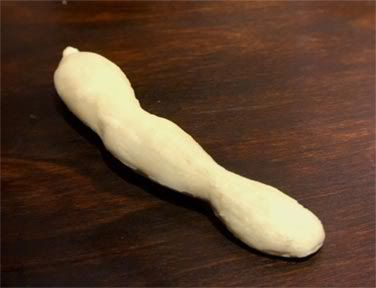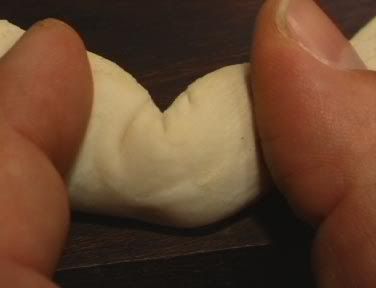
I asked about the bubbles on both the Sculptor's Forum and SMA, and got some good answers. The concensus is that the bubbles were already there, just under the surface, and that the solvent softened up the silicone enough so when I rubbed over it I broke right through the thin skin. Apparently when you mix the catalyst into the silicone you create lots of tiny little micro-bubbles, and they stay in the mix, just under the surface, or they can rise to the surface. My thought is that I avoided similar problems on the other arm castings because of the way I made them... I partially filled each mold half and baked them separately, and the bubbles rose to the surface, which was toward the center of the arm. But now I've tried my next experiment, which is getting close to the results I want for the actual puppets. I'll detail the process, partly so I can remember, and also to help anyone following in my footsteps.
I started by painting in a layer of pure Dragonskin, no softener added, no pigmets. This is much thicker than the softened silicone, and will stay in place on the mold walls rather than just run right to the bottom, plus is translucent, so the pastel powder will show through. It's important to actually brush it into the mold to break up any bubbles. As long as you have this thin skin it doesn't matter if there are bubbles inside... after all, that's what foam latex is, just a thin skin and inside it looks like a sponge. Ok, so with a thin skin brushed up in the mold halves, I then ground up some pastels on my trusty sandpaper, a few colors to create the mix I wanted, and I sort of tapped on the piece of sandpaper while holding it tilted over the mold halves, so pastel powder sprinkled down into them. I was hoping it would stick to the silicone, but it really didn't, so I decided I needed to paint another layer behind it. This got really messy, as it sort of gummed up and tried to pull the first layer out and ther pastel dust kind of turned into a bunch of thick lumps. Maybe next time I need to cure the outer layer first. But it worked surprisingly well in spite of this.
At this point I put both halves in the oven to cure for half an hour. I didn't bother making an armature for this one, I just wanted to test intrinsic painting using pastels and a solid pour technique for filling the mold. In my first few attempts I tried to fill each half of the mold and then slap them together, which never quite worked the way it does with foam latex, which is light and fluffy and holds its consistency... so this time I cut a channel to pour silicone into. After pulling the mold halves out of the oven with the cured skin inside I strapped them together (first I had to trim a little stray silicone out that would have kept them from closing completely) and then I poured the rest of the silicone in, after adding the thinner and some pigment, white with just a touch of flesh. I was really expecting silicone to come pouring out the bottom of the mold, or maybe to wait until I stood it in the oven and then run out onto the bottom heating element, but amazingly it held! And when I demolded it 30 minutes later, I had the best casting yet.

Here you can see one problem I still want to address. Because the skin is made with unthinned silicone and the stuff inside is much softer, it has a tendency to wrinke. But there might be a nice solution.... possibly if I mix the pastel dust right into the initial layer of silicone it might become thick enough to stay put on the mold walls, meaning that I can use thinned silicone even for the skin. A little more experimentation is called for, then it's on to actually making some puppet parts!
*EDIT*
Wow, I can really lay on the blablabla without saying the important stuff, can't I? The sweet thing about this intrinsic coloring technique is that now I don't need to spray deadly toxic solvents all over in the basement. That's all I was trying to say.

2 comments:
Its great to see you making strides...seems to be getting easier for you, which is good news for the rest of us :)
No fumes is good....
I feel like the pure testing phase is over now, it's on to actually making some puppet parts. I still want to try painting with a brush though using the solvent... a little better than fumigating the basement (not much though). Maybe I'll even try brush painting with no solvent involved. Could be good for those few touches that you can't really do intrinsically.
Post a Comment